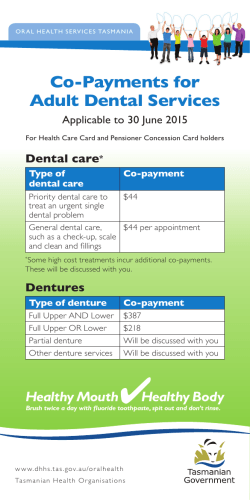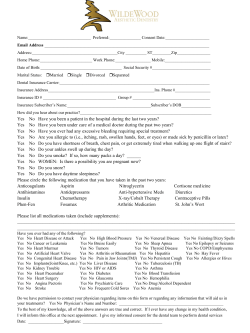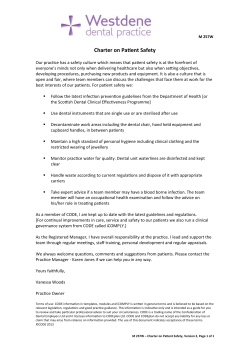
Cast partial denture-A non-motivated treatment option in the present
Downloaded from www.medrech.com “Cast partial denture-A non-motivated treatment option in the present era” Medrech ISSN No. 2394-3971 Case Report CAST PARTIAL DENTURE-A NON-MOTIVATED TREATMENT OPTION IN THE PRESENT ERA Khurshid Mattoo 1, Shujaurrahman 2, Lakshya Yadav3 1 Department of Prosthodontics, College of dentistry, Jazan University, (KSA) Department of Prosthodontics, Subharti dental college, Subharti University, Meerut, (India) 3 Department of Prosthodontics, King George dental college, KGM University, Lucknow, (India) 2 Submitted on: February 2015 Accepted on: March 2015 For Correspondence Email ID: Abstract: Widespread demand for fixed Prosthodontics has seen a drastic reduction in the deliverance of cast partial denture as a treatment option in many partial edentulous situations. Although it is right for the patient to demand any treatment option but it becomes the prime duty of the practitioner to deliver what is good for the patient in such situation. Unfortunately, the option for cast partial denture as a treatment option is fast becoming obsolete presently due to many factors including financial. Motivating patients to choose such option has to be backed up with adequate results. This article presents a case report of an adult female who wanted only a fixed prosthesis, but through education and motivation received a cast partial denture which was the only indicated prosthesis in her case. Introduction Increased life expectancy and substantial growth of the population indicates there will be a large and growing need for fixed and removable Prosthodontics despite advances in preventive dentistry. With the advent of implant supported dental prosthesis, there has been also an increase in the demand of fixed prosthodontic options. On the other side, removable partial dentures are now used less frequently despite the fact that where fixed prosthodontics is not indicated, the treatment of choice is usually the cast partial denture (CPD). In short, Cast partial denture as a treatment option is not getting the boost that it should have got in the field of removable Prosthodontics. Prescribing, designing and fabricating of a cast partial denture has been a problem in prosthetic dentistry, a fact which is well known. 1-3 Besides these established facts, there are also additional problems that include dental laboratories receiving master impressions with little or no input from dentists, relying on dental laboratory to design the cast partial denture and finally inadequately designed RPDs that are badly tolerated by the patients. 4-8 Mattoo K. et al., Med. Res. Chron., 2015, 2 (2), 191-194 Medico Research Chronicles, 2015 Keywords: partial edentulism, casting, patient education, motivation, dental implant. 191 Downloaded from www.medrech.com These evidences when summed up with the fact that a cast partial denture generates less economics and consumes more practitioners' time has created a bias towards their prescription even though they yield less failures. If a practitioner has to go with the patient’s wishes, then there would hardly be a very few percent of patients who would prefer a removable partial denture. On the contrary, when a fixed partial denture is not indicated in a particular partial edentulous situation, it becomes the duty and responsibility of the dentist to educate and motivate the patient of his existing condition. Recognizing the significance of educating and motivating a patient to wear a cast partial denture, this article reports a case of a highly aesthetic conscious female patient, who wanted a fixed prosthesis at any cost but was later comfortable and happy with a conventional cast partial denture. Clinical Report An adult female patient aged 28 years, was referred to the department of Prosthodontics of the University with chief complaint of inability to masticate since the loss of her mandibular posterior teeth (second premolar, first molar and second molar on the right side and second premolar on left side). Medical, drug and social history were non-contributory. Dental history recorded a loss of mandibular teeth due to caries. The patient was highly concerned about the negative impact on aesthetics due to tooth loss. Extra oral functional examination disclosed a low, high lip line (smiling lion). Intra oral examination revealed (Kennedy class 3 modification 1) partial edentulous situation with a long span on one side and a short span on the other. Wear facets in relation to posterior teeth were present with prominent effect on anterior guidance in relation to maxillary and mandibular canines (Fig 1A). Diagnosis and treatment plan was done after radiographic investigations and a diagnostic mounting on a semi adjustable articulator. After presenting different treatment options, the patient wanted a fixed prosthodontic treatment. After necessary evaluation the patient was educated about the non-possibility of any fixed prosthesis in her case and the reasons for it. The patient was also educated about the benefits of the removable prosthesis in relation to her case and future implications of both treatment options. Finally the patient agreed for removable partial Prosthodontics and gave her consent to the treatment. Primary cast obtained for diagnostic evaluation was surveyed on a dental cast surveyor and four principal factors were evaluated, namely the path of insertion and removal, aesthetic, interferences and guiding planes. Mouth preparations were then done in the next appointment following which final impressions were made using different consistencies of Addition polyvinyl siloxane material (Reprosil, Dentsply/Caulk; Milford, DE, USA) on a special tray. The metal framework for the RPD was then tried in the patient’s mouth following which the denture base and the artificial teeth were attached to the RPD. All direct retainers were adjusted in the terminal third of their retentive tips to ensure adequate adaptation (Fig 1A and B). Adequate relief was only ensured for the major connector (Fig 1C). Patient’s esthetics and smile were evaluated for not demonstrating any component of the direct retainer anteriorly (Fig 1D). The patient was put on a strict follow up protocol for a period 3 months during which she adapted well to the prosthesis. Discussion Rehabilitation of a partially dentate patient is an important form of dental treatment that is expected with competence from every qualified dentist regardless of the place/school of training. For a cast partial denture to be successful for a patient, the practitioner has to show determination in terms of making his patients understand the Mattoo K. et al., Med. Res. Chron., 2015, 2 (2), 191-194 Medico Research Chronicles, 2015 “Cast partial denture-A non-motivated treatment option in the present era” 192 Downloaded from www.medrech.com “Cast partial denture-A non-motivated treatment option in the present era” benefits of such treatment option. Long span edentulous areas, especially involving the posterior segments require adequate tooth support to satisfy Antes law in terms of fixed partial denture. As in the present case the patient preference was to have a fixed partial denture after it was concluded that she was not indicated for an implant supported fixed partial denture or single supported crowns. The edentulous span included the second premolar, first and second molar and abutment on either side of the edentulous areas were not sufficient for long term success. Short clinical crowns, gingival recession, chronic gingivitis and type of occlusion were other factors that were not conducive for a fixed partial denture. Perhaps the significant motivation for the patient came when she was explained and understood about the cross arch support and stabilization that was unique to the cast partial denture. This was explained to her on the diagnostic cast and some visuals on a laptop. Patients visiting a dental practitioner always come with some beliefs and taboos that they associate with the particular treatment option. In prosthetic dentistry, patients do not want to wear a removable partial denture due to various reasons like fear of becoming loose or coming out, swallowing, hygiene and convenience. 9Any such pre perceptions regarding any treatment modalities should be identified and strategic planning for that particular patient at the end should allay all his/her fears. Every patient needs to be educated with determination till he does not understand his partial edentulous situation. 10,11 However, when a practitioner is biased towards a particular form of dental treatment which is economically more lucrative there is case of moral and ethics involved. But in this fast changing competitive world forensic implications in terms of jurisprudence may finally evolve to include such bias on the part of a dental practitioner as a form of malpractice. Conclusion Treatment options in prosthetic dentistry or in any other medical field should not be subjected to practitioner’s bias, especially where economic interests exist. Less demand is also due to very less execution of such treatment options. References 1. Petropoulos VC, Rashedi B. Removable partial denture education in U.S. dental schools. J Prosthodont. 2006; 15:62-8. 2. Basker RM, Harrison A, Davenport JC, Marshall JL. Partial denture design in general dental practice--10 years on. Br Dent J.1988; 165:245-9. 3. Lynch CD, Allen PF. A survey of chrome-cobalt RPD design in Ireland. Int J Prosthodont. 2003; 16:362-4. Mattoo K. et al., Med. Res. Chron., 2015, 2 (2), 191-194 Medico Research Chronicles, 2015 Figure 1: (A) Simple circlet clasps on the left side (B) Direct retainers on the right side (C) Cast partial denture in place (D) Extra oral view after placement of the cast partial denture 193 Downloaded from www.medrech.com “Cast partial denture-A non-motivated treatment option in the present era” removable partial prostheses in the Kingdom of Bahrain. J Oral Rehabil. 2007; 34:153-7. 8. Schwarz WD, Barsby MJ. Design of partial dentures in dental practice. J Dent. 1978; 6:166-70. 9. Owall B, Budtz-Jörgensen E, Davenport J, Mushimoto E, Palmqvist S, Renner R, et al. Removable partial denture design: a need to focus on hygienic principles? Int J Prosthodont. 2002; 15:371-8. 10. Lechner SK, Thomas GA, Bradshaw M. An interactive multimedia solution to learning removable partial denture design. J Prosthodont. 1998; 7:177-82. 11. Jepson NJ, Thomason JM, Steele JG. The influence of denture design on patient acceptance of partial dentures. Br Dent J. 1995; 178:296-300. Medico Research Chronicles, 2015 4. Lynch CD, Allen PF. Quality of written prescriptions and master impressions for fixed and removable prosthodontics: a comparative study. Br Dent J. 2005; 198:17-20. 5. Kilfeather GP, Lynch CD, Sloan AJ, Youngson CC. Quality of communication and master impressions for the fabrication of cobalt chromium removable partial dentures in general dental practice in England, Ireland and Wales in 2009. J Oral Rehabil. 2010; 37:300-5. 6. Schwarz WD, Barsby MJ. A survey of the practice of partial denture prosthetics in the United Kingdom. J Dent. 1980; 8:95-101. 7. Radhi A, Lynch CD, Hannigan A. Quality of written communication and master impressions for fabrication of Mattoo K. et al., Med. Res. Chron., 2015, 2 (2), 191-194 194
© Copyright 2025









